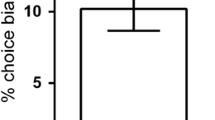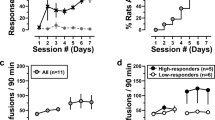Abstract
Schedules which selectively reinforce low rates of responding (DRL, differential reinforcement of low rate) distinguish between antidepressants and other types of drugs. In a DRL schedule a subject is required to pause for a specified minimum period of time between two consecutive responses in order to obtain a reinforcer. The dependent variables are rate of responding and rate of reinforcement. Response patterns of rats treated with clinically effective antidepressant drugs such as imipramine (2.0–32.0 mg/kg) or fluvoxamine (4.0–32.0 mg/kg) are characterized by a decrease in response rate and an increase in reinforcement rate. Treatment with the 5-HT1A agonist flesinoxan (0.1–3.0 mg/kg) also dose-dependently decreased response rates while at the same time increasing reinforcement rates. Chlordiazepoxide (2.5–20.0 mg/kg) and diazepam (0.25–2.0 mg/kg) had no effects in the present experiment.d-Amphetamine increased response rates at low doses (0.5–2.0 mg/kg), and decreased it at the higher doses (4.0 mg/kg), but reinforcement rates were unaltered. Overall analysis of the effects of haloperidol (0.02–0.32 mg/kg) showed decreased responding and increased reinforcement rates. Post hoc analysis, however, clearly differentiated between haloperidol's profile and that of the antidepressants. As such, the results of the present experiment show that flesinoxan might possess antidepressant activity in humans.
Similar content being viewed by others
References
Amsterdam JD, Berwish N, Potter L, Rickels K (1987) Open trial of gepirone in the treatment of major depressive disorder. Curr Ther Res Clin Exp 41:185–193
Barrett JE, Glesson S, Nader MA, Hoffmann SM (1989) Anticonflict effects of the 5-HT1A compound flesinoxan. J Psychopharmacol 3:64–69
Britton KT, Koob GF (1989) Effects of corticotropin releasing factor, desipramine and haloperidol on a DRL schedule of reinforcement. Pharmacol Biochem Behav 32:967–970
Cervo L, Grinaschi G, Samanin R (1988) 8-Hydroxy-2-(di-n-propylamino)tetralin, a selective serotonin1A receptor agonist, reduces the immobility of rats in the forced swimming test by acting on the nucleus raphe dorsalis. Eur J Pharmacol 158:53–59
Chojnacka-Wójcik E, Tatarczynska E, Golembiowska K, Przegalinski E (1991) Involvement of 5-HT1A receptors in the antidepressant-like activity of gepirone in the forced swimming test in rats. Neuropharmacology 30:711–718
Cott JM, Kurtz NM, Robinson DS, Copp JE (1988) A 5-HT1A ligand with both antidepressant and anxiolytic activity. Psychopharmacol Bull 24:164–167
Dews PB, Wenger GR (1977) Rate-dependency of the behavioural effects of amphetamine. In: Thompson T, Dews PB (eds) Advances in behavioural pharmacology, vol 1. Academic Press, New York, pp 167–227
Goodwin GM (1989) The effects of antidepressant treatments and lithium upon 5-HT1A receptor function. Prog Neuropsychopharmacol Biol Psychiatry 13:445–451
Howard JL, Pollard GT (1984) Effects of imipramine, bupropion, chlorpromazine, and clozapine on differential-reinforcement-of-low-rate (DRL) > 72-sec and > 36-sec schedules in rat. Drug Dev Res 4:607–616
Kennett GA, Curzon G (1989) Mechanism of action of 8-OH-DPAT on a rat model for human depression. In: Bevan P, Cools A, Archer T (eds) Behavioural pharmacology of 5-HT. Lawrence Erlbaum, London 225–229
Kennett GA, Dourish CT, Curzon G (1987) Antidepressant-like action of 5-HT1A agonists and conventional antidepressants in an animal model of depression. Eur J Pharmacol 134:265–274
Li AA, Marek GJ, Hand TH, Seiden LS (1990) Antidepressant-like effects of trazodone on a behavioural screen mediated by trazodone, not the metabolite m-chlorophenylpiperazine. Eur J Pharmacol 177:137–144
Marek GJ, Seiden LS (1988) Selective inhibition of MAO-A, not MAO-B, results in antidepressant-like effects on DRL 72-s behaviour. Psychopharmacology 96:153–160
Marek GJ, Li AA, Seiden LS (1989a) Selective 5-hydroxytryptamine2 antagonists have antidepressant-like effects on differential-reinforcement-of-low-rate 72-second schedule. J Pharmacol Exp Ther 250[1]:52–59
Marek GJ, Li AA, Seiden LS (1989b) Evidence for involvement of 5-hydroxytryptamine1 receptors in antidepressant-like drug effects on differential-reinforcement-of-low-rate 72-second behaviour. J Pharmacol Exp Ther 250[1]:60–71
McGuire PS, Seiden LS (1980a) The effects of tricyclic antidepressants on performance under a differential-reinforcement-of-low-rate schedule in rats. J Pharmacol Exp Ther 214:635–641
McGuire PS, Seiden LS (1980b) Differential effects of imipramine in rats as a function of DRL schedule value. Pharmacol Biochem Behav 13:691–694
O'Donnell JM, Seiden LS (1982) Effects of monoamine oxidase inhibitors on performance during differential reinforcement of low response rate. Psychopharmacology 78:214–218
O'Donnell JM, Seiden LS (1983) Differential-reinforcement-of-low-rate 72-sec schedule: selective effects of antidepressant drugs. J Pharmacol Exp Ther 224:80–88
Pearl RG, Seiden LS (1976) The existence of tolerance to and cross-tolerance between d-amphetamine and methylphenidate for their effects on milk consumption and on differential-reinforcement-of-low-rate performance in the rat. J Pharmacol Exp Ther 198:635–647
Pollard GT, Howard JL (1986) Similar effects of antidepressant and non-antidepressant drugs on behaviour under an interresponse-time > 72-s schedule. Psychopharmacology 89:253–258
Porsolt RD (1981) Behavioural despair. In: Enna SJ, Malick JB, Richelson E (eds) Antidepressants: neurochemical, behavioural and clinical perspectives. Raven Press, New York, pp 121–139
Schipper J, Tulp M, Sybesma H, Krijzer F, Mos J, van der Heyden J, Olivier B (1990) Preclinical evaluation of flesinoxan as a potential anxiolytic and antidepressant drug. Eur J Pharmacol 183:2059–2060
Schipper J, Tulp M, Berkelmans HS, Krijzer F, van der Heyden J, Olivier B (1991a) Flesinoxan: antidepressant activity in animal models. Soc Neurosci Abstr 17:1357
Schipper J, Tulp M, Berkelmans HS, Mos J, van der Heyden J, Olivier B (1991b) Preclinical pharmacology of lesinoxan: a potential anxiolytic and antidepressant drug. Hum Psychopharmacol Clin Exp 6:S53-S63
Schoeffter P, Hoyer D (1988) Centrally acting hypotensive agents with affinity for 5-HT1A binding sites inhibit forskolin-stimulated adenylate cyclase activity in calf hippocampus. Br J Pharmacol 95:975–985
Schweizer EE, Amsterdam J, Rickels L, Kaplan M, Droba M (1986) Open trial of buspirone in the treatment of major depressive disorder. Psychopharmacol Bull 22:183–185
Seiden LS, Dahms JL, Shaughnessy RA (1985) Behavioural screen for antidepressants: the effects of drugs and electroconvulsive shock on performance under a differential-reinforcement-of-low-rate schedule. Psychopharmacology 86:55–60
Sulser F (1983) Noradrenergic receptor regulation and the action of antidepressants. In: Depression and antidepressants — recent events. Excerpta Medica, Amsterdam, pp 24–36
Tatham TA, Zurn KR (1989) The MED-PC experimental apparatus programming system. Behav Res Methods Instrum Comp 21[2]:294–302
Ybema CE, Slangen JL, Olivier B, Mos J, (1990) Discriminative stimulus properties of flesinoxan. Pharmacol Biochem Behav 35:781–784
Ybema CE, van den Broek I, Slangen JL, Olivier B, Mos J (1991) Further study on the discriminative stimulus properties of flesinoxan. In: Olivier B, Mos J, Slangen JL (eds) Animal models in psychopharmacology. Birkhauser, Basel, Switzerland, pp 387–395
Author information
Authors and Affiliations
Rights and permissions
About this article
Cite this article
van Hest, A., van Drimmelen, M. & Olivier, B. Flesinoxan shows antidepressant activity in a DRL 72-s screen. Psychopharmacology 107, 474–479 (1992). https://doi.org/10.1007/BF02245258
Received:
Revised:
Issue Date:
DOI: https://doi.org/10.1007/BF02245258




